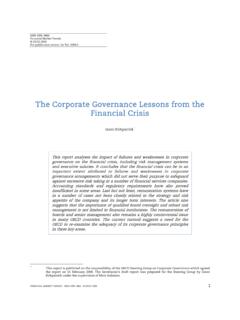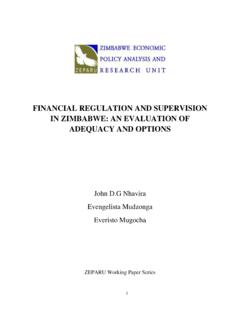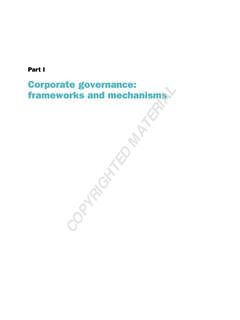Transcription of Basel Committee on Banking Supervision
1 Basel Committee on Banking Supervision The internal audit function in banks June 2012 This publication is available on the BIS website ( ). Bank for International Settlements 2012. All rights reserved. Brief excerpts may be reproduced or translated provided the source is cited. ISBN 92-9131- 140-5 (print) ISBN 92-9197- 140-5 (online) The internal audit function in banks i Contents Introduction .. 1 Overview of the principles .. 2 A. Supervisory expectations relevant to the internal audit function .. 3 1. The internal audit function .. 4 2. Key features of the internal audit function .. 4 3. The internal audit charter .. 7 4. Scope of activity .. 7 5. corporate governance considerations .. 9 6. Internal audit within a group or holding company structure .. 13 7. Outsourcing of internal audit activities .. 14 B. The relationship of the supervisory authority with the internal audit function .. 14 1.
2 Benefits of enhanced communication between the supervisory authority and the internal audit function .. 15 2. Potential topics for discussion between supervisors and internal audit .. 16 C. Supervisory assessment of the internal audit function .. 17 1. Assessment of the internal audit function .. 17 2. Actions to be undertaken by the supervisory authority .. 18 Annex 1: Internal audit function's communication channels .. 19 Annex 2: Responsibilities of a bank's audit Committee .. 21 ii The internal audit function in banks Members of the Accounting Task Force s Audit Subgroup of the Basel Committee on Banking Supervision Chairman: Mr Marc Pickeur National Bank of Belgium Representatives in italics provided drafting support Office of the Superintendent of financial Institutions, Canada Ms Laural Ross Ms Ruby Garg Bank of France Ms Nathalie Boutin Prudential Supervisory Authority, France Ms Sylvie Marchal Deutsche Bundesbank, Germany Bundesanstalt f r Finanzdienstleistungsaufsicht, Germany Ms Dragomira Berberova Ms Stefanie Jessen Banca d Italia, Italy Ms Lidja Schiavo Bank of Japan Mr Hiroyuki Yoshida Ms Keiko Sumida financial Services Agency, Japan Mr Tadashi Tsumori Commission de Surveillance du Secteur Financier, Luxembourg Ms Martine Wagner De Nederlandsche Bank, The Netherlands Mr Nic van der Ende Banco de Espa a, Spain Ms Barbara Olivares financial Services Authority, United Kingdom Ms Patricia Sucher Mr Robert Konowalchuk Ms Veenu Mittal Board of Governors of the Federal Reserve System, United States Mr Terrill Garrison Office of the Comptroller of the Currency.
3 United States Mr Robert Riordan Federal Deposit Insurance Corporation, United States Mr Harrison Greene Secretariat Secretariat of the Basel Committee on Banking Supervision Mr Xavier-Yves Zanota The internal audit fu nction in banks 1 Introduction 1. The Basel Committee on Banking Supervision (the Committee ) is issuing this revised supervisory guidance for assessing the effectiveness of the internal audit function in banks, which forms part of the Committee s ongoing efforts to address bank supervisory issues and enhance Supervision through guidance that encourages sound practices within banks. The document replaces the 2001 document Internal audit in banks and the supervisor s relationship with auditors. It takes into account developments in supervisory practices and in Banking organisations and incorporates lessons drawn from the recent financial crisis. 2. The Committee s Principles for Enhancing corporate Governance1 states that banks should have an internal audit function with sufficient authority, stature, independence, resources and access to the board of directors.
4 Independent, competent and qualified internal auditors are vital to sound corporate governance . 3. A strong internal control system, including an independent and effective internal audit function, is part of sound corporate governance . Banking supervisors must be satisfied as to the effectiveness of a bank's internal audit function, that policies and practices are followed and that management takes appropriate and timely corrective action in response to internal control weaknesses identified by internal auditors. An internal audit function provides vital assurance to a bank s board of directors and senior management (and bank supervisors) as to the quality of the bank s internal control system. In doing so, the function helps reduce the risk of loss and reputational damage to the bank. 4. This document addresses supervisory expectations for the internal audit function in Banking organisations, t he relationship of the supervisory authority with the internal audit function and the supervisory assessment of that function.
5 This document seeks to promote a strong internal audit function within Banking organisations and to provide guidance for the supervisory assessment of this function. 5. This document also encourages bank internal auditors to comply with and to contribute to the development of national and international professional standards, such as those issued by The Institute of Internal Auditors, and it promotes due consideration of prudential issues in the development of internal audit standards and practices. 6. This document refers to a management structure comprised of a board of directors2 and senior management. The Committee recognises that significant differences exist in legislative and regulatory frameworks between countries. These national frameworks shape the role and function of management and governance structures. In some countries the board of directors has the main, if not exclusive, function of overseeing the executive body, often referred to as senior management, and ensuring that it fulfils its responsibilities.
6 For this reason it is sometimes known as a supervisory board that has no executive functions. In contrast, in other countries the board has a broader remit in that it lays down the general framework for the management of the bank. Owing to these differences, the concepts of the board of directors and senior management are used in this document not to identify legal constructs but rather to label two decision-making functions within a bank. 1 BCBS website: 2 In this document, the terms board of directors and board are both used and have the same meaning. 2 The internal audit function in banks 7. The principles set out in this document should be applied in accordance with the national legislation and corporate governance structures applicable in each country. 8. For large banks and internationally active banks, an audit Committee (or its equivalent) is typically responsible for providing oversight of the bank s internal auditors.
7 Such a Committee is established within the board of directors. Annex 2 of this document provides more details about the responsibilities of audit committees . In this document, references to the board of directors presume appropriate involvement of its audit Committee , when one exists. In line with the Committee 's Principles for Enhancing corporate governance , paragraph 50, this document assumes that large and internationally active banks have an audit Committee or its equivalent. Other banks are strongly encouraged to establish such a Committee . 9. This guidance applies to all banks, including those within a Banking group, and to holding companies whose subsidiaries are predominantly banks and to those holding companies subject to prudential Supervision whose subsidiaries are predominantly banks. All of these structures are referred to as banks or Banking organisations in this document.
8 The extent of application of this guidance should be commensurate with the significance, complexity and international presence of the bank (principle of proportionality). Overview of the principles Principles relating to the supervisory expectations relevant to the internal audit function Principle 1: An effective internal audit function provides independent assurance to the board of directors and senior management on the quality and effectiveness of a bank s internal control, risk management and governance systems and processes, thereby helping the board and senior management protect their organisation and its reputation. Principle 2: The bank's internal audit function must be independent of the audited activities, which requires the internal audit function to have sufficient standing and authority within the bank, thereby enabling internal auditors to carry out their assignments with objectivity. Principle 3: Professional competence, including the knowledge and experience of each internal auditor and of internal auditors collectively, is essential to the effectiveness of the bank s internal audit function.
9 Principle 4: Internal auditors must act with integrity. Principle 5: Each bank should have an internal audit charter that articulates the purpose, standing and authority of the internal audit function within the bank in a manner that promotes an effective internal audit function as described in Principle 1. Principle 6: Every activity (including outsourced activities) and every entity of the bank should fall within the overall scope of the internal audit function. Principle 7: The scope of the internal audit function s activities should ensure adequate coverage of matters of regulatory interest within the audit plan. Principle 8: Each bank should have a permanent internal audit function, which should be structured consistent with Principle 14 when the bank is within a Banking group or holding company. The internal audit fu nction in banks 3 Principle 9: The bank s board of directors has the ultimate responsibility for ensuring that senior management establishes and maintains an adequate, effective and efficient internal control system and, accordingly, the board should support the internal audit function in discharging its duties effectively.
10 Principle 10: The audit Committee , or its equivalent, should oversee the bank s internal audit function. Principle 11: The head of the internal audit department should be responsible for ensuring that the department complies with sound internal auditing standards and with a relevant code of ethics. Principle 12: The internal audit function should be accountable to the board, or its audit Committee , on all matters related to the performance of its mandate as described in the internal audit charter. Principle 13: The internal audit function should independently assess the effectiveness and efficiency of the internal control, risk management and governance systems and processes created by the business units and support functions and provide assurance on these systems and processes. Principle 14: To facilitate a consistent approach to internal audit across all the banks within a Banking organisation, the board of directors of each bank within a Banking group or holding company structure should ensure that either: (i) the bank has its own internal audit function, which should be accountable to the bank s board and should report to the Banking group or holding company's head of internal audit; or (ii) the Banking group or holding company's internal audit function performs internal audit activities of sufficient scope at the bank to enable the board to satisfy its fiduciary and legal responsibilities.















